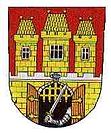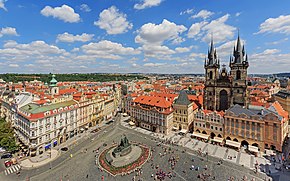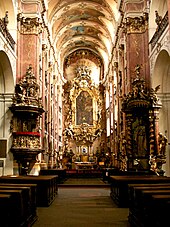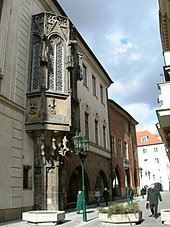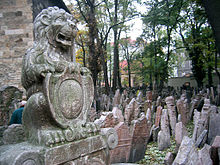Prague old town
| Staré Město | |||
|---|---|---|---|
|
|||
| Basic data | |||
| State : |
|
||
| Region : | Hlavní město Praha | ||
| Municipality : | Praha | ||
| Administrative district : | Prague 1 | ||
| Area : | 129 ha | ||
| Geographic location : | 50 ° 5 ' N , 14 ° 25' E | ||
| Residents : | 9,037 (December 31, 2015) | ||
| structure | |||
| Status: | Cadastral parish | ||

The Prague Old Town ( Czech : Staré Město ) is the oldest of the four Prague cities (Old Town, New Town , Lesser Town and Hradcany ). Its center is the Old Town Square (Staroměstské náměstí) with numerous sights.
history
Roots and founding of the city
In the 11th and 12th centuries, under the protection of the two castles, the Prague Castle and the Vyšehrad , along the Vltava and the connecting roads, German and Jewish merchants and local craftsmen settled. A major reason for this was the location at the crossroads of important trade routes and the existence of a ford through the Vltava and a bridge. Most of the loose settlements already had their own parish and cemetery churches.
Wenceslaus I (1230–1253) had the largest of these Romanesque settlements on the Vltava bend fortified around 1230/34 and raised it to the status of a royal city . Prague became the royal seat of the Bohemian kings. On the one hand, the city fortification cut up settlements like around St. Martin in der Mauer (Kostel sv. Martina ve zdi) , on the other hand, previously undeveloped areas were included in the wall ring, which were then built on quite quickly.
The later royal mint master Eberhard founded the Gallus city Nova civitas circa S. Gallum ( Havelské město ) with south German colonists, which had its own legal system until the city charter of the old town was unified around 1287. It was built around a regularly laid out "New" market (Nové tržiště) , which stretched from today's fruit market (Ovocný trh) to the coal market (Uhelný trh) . These names have only existed since 1870, before they were collectively called Neumarkt or Gallimarkt.
Even under Wenceslas I, the first mendicant orders settled in the old town. The Dominicans had their headquarters to the Renaissance at St Clement's Church (now part of the Klementinum ) at the Charles Bridge. Wenceslas I founded a monastery for the Franciscans at the later St. James Church (Kostel sv. Jakuba) .
Fortification of the old town
The construction of the high Gothic fortification of the old town was completed before 1310. The walls of the old town were 10 to 12 m high and lined with battlements. In front of her was a 15 to 20 m wide kennel with a lower kennel wall and a 25 m wide and 8 m deep trench and wall with a palisade. Around every 60 m there were square towers up to 30 m high. The old town had a total of 13 gates and towers, of which only the Gallus Gate was partially preserved. The moat between the old and the new town , founded in 1348, was only filled in between 1760 and 1781, when a united Prague town fortification was created. Its course is marked today by the streets Revoluční , Na příkopě (At the moat), 28. října and Národní třida .
Expansion in the 14th century
In the old town there was a construction boom as early as the 1330s, which was increased again under Charles IV and Wenceslaus IV . Almost all parish and monastery churches were changed and expanded. In 1346 the Holy Spirit Church (Kostel sv. Ducha) and 1339–1371 the St. Giles Church (Kostel sv. Jiljí) were rebuilt; the St. Nicholas Church (Kostel sv. Mikuláše) , around 1350 St. Martin in the Wall (Kostel sv. Martina ve zdi) and around 1370 St. Castulus (Kostel sv. Haštala) and also in the 1470s Century St. Michael (Kostel sv. Michala) were rebuilt. After the head of St. Gallus came to Prague from St. Gallen , the St. Gallus Church (Kostel sv. Havla) was enlarged from 1353 onwards . In 1374, the construction of the new monastery church of the Franciscan St. Jacob (Kostel sv. Jakuba) , which began in 1319 under Johann von Luxemburg , was completed. In 1370 the new construction of the Tyn Church (Kostel Panny Marie před Týnem) began . After the death of Charles IV in 1380, the Dombauhütte Peter Parlers continued the construction of the three-aisled Gothic basilica, the completion of which was interrupted by the Hussite Wars .
There was also construction activity on numerous secular buildings. The Old Town Hall (Staroměstská radnice) , which only existed from 1338, was expanded several times and a mighty corner tower was added by 1364. In addition, around 1360 an unknown construction works added a bay window with a chapel to the town hall, which was consecrated to the Virgin Mary in 1381. The Rothlöwsche Haus, which Wenzel IV had donated to the university in 1383 and which is now part of the Carolinum, was given a similar bay window with a pillar as part of a former house chapel . Similar to the market halls at the cattle market , an approximately 200 m long stone market hall (Kotce) with shops on both sides of a wide aisle was built around 1360 west of the St. Gallus Church .
At the eastern exit of the old town, Wenceslaus IV had a new royal court built, to which he moved from Prague Castle in 1383 and which served as the residence of the Bohemian rulers until 1484. To the south of Zeltnergasse (Celetná) was the queen's palace.
Under Karl, the construction of a new stone bridge over the Vltava, today's Charles Bridge, began in 1357 after the 12th century Judith Bridge , which was located just north of the new bridge, was destroyed by floods in 1342. First of all, a wooden temporary structure was built on the old bridge piers of the destroyed Judith Bridge, which accommodated all traffic until the new bridge was built.
In 1991 the old town of Prague had 13,040 inhabitants. In 2001 the district consisted of 627 residential buildings in which 10,531 people lived.
Attractions
The most famous sights of the old town are on the Old Town Square . The Republic Square (Náměstí Republiky) with the Powder Tower (Prašná brána) and the Art Nouveau Representative House or Municipal House ( Obecní dům ) are located on the border between the Old and New Towns .
St. Jacob Church
Wenceslas I settled Franciscans in the old town in 1232 and founded a monastery at the later Basilica of St. Jacob (Kostel sv. Jakuba) . No building remains from the Romanesque-Early Gothic era have survived. In 1319 King John of Luxembourg laid the foundation stone for a new choir and in 1335 for the nave, the construction of which was completed under Charles IV in 1374. The three-aisled high Gothic basilica with two towers is the second longest church in Prague. The sacristy north of the choir still has the original cross vaults and consoles. After a fire in 1689–1702, the church was redesigned in Baroque style and equipped with a new barrel vault lowered by five meters and galleries above the two side aisles. The interior was also redesigned in high baroque style between 1736 and 1739. The three large stucco groups with St. James (center), St. Francis (left) and St. Anthony on the preserved Gothic main facade were created by the Italian sculptor Ottavio Mosto in 1695.
Remains of the north and west wings from around 1330 still exist of the monastery, which was converted into a school in 1841.
Carolinum
The Prague University , founded by Charles IV on April 7, 1348 , did not initially have a teaching building, but instead taught in private houses and monasteries. In 1383 Wenzel IV donated a house to the university, built around 1370 for the mint master Johlin Rotlöw, which he had bought or received as a gift. It was called " Collegium Carolinum " , the current address is Železná ul. 9 (Eisengasse 9) and Ovocný trh No. 3 (fruit market 3). The auditorium, lecture halls and apartments were then built for the Masters. Among other things, Magister Jan Hus had worked there as rector.
After the defeat in the Battle of White Mountain , the building was handed over to the Jesuits in 1620 . Franz Maximilian Kaňka redesigned it in the Baroque style in 1718. The large auditorium was built, which extended over the first and second floors. To this day the doctorates are carried out there. The building was restored by Josef Mocker in 1881/82 and again in the 1950s. It has since been expanded by several buildings and is still used by the Philosophical Faculty of Charles University.
From the original building, the bay window of a former private house chapel has been preserved, which was probably built around 1380 and was dedicated to Saints Cosmas and Damian . Figures that have been lost once stood between the windows. The canopies and gargoyles , the ornamental gables and the tracery gallery are still original.
Gallusstadt market hall
On the market of the Gallusstadt, founded in 1232-34, an approximately 200 m long stone market hall ( Kotce ( Pl. ), German: stalls ) with shops on both sides of a wide aisle, today's street V kotcích , was built west of the Gallus Church . In houses CN 514 and CN 251 there are still remains of the walls of the sales booths. The market hall was demolished in 1795, and in its place were built in the mid-19th century on three new streets: Kotzengasse (V kotcích) , Rittersgasse (Rytířská) and Gallusgasse (Havelská) . Only the outside of the last two streets still show the development before this time. This is particularly evident in the arcades in Havelská from the end of the 14th / beginning of the 15th century. Today there are wooden market stalls in these streets again.
St. Gallus Church
The St. Gallus Church (Kostel sv. Havla) was laid out in 1232 at the same time as the Gallus city and was completed by 1263. It was one of the four old town parish churches. After the head of St. Gallus had been transferred from St. Gallen to Prague, the church was rebuilt in a high Gothic style from 1353 and a whole double nave was added to the north. John of Nepomuk (1380–90) and Jan Hus (1404) preached in the church . In 1627 the church was handed over to the Order of the Shod Carmelites , who erected monastery buildings in 1671 - the cloister and refectory have been preserved - and at the end of the 17th century Giovanni Domenico Orsi de Orsini had the church rebuilt in baroque style. The towers, among other things, date from this period. The church did not receive the wave-shaped facade until 1723–1739.
House of the Old Town Mayor
The Old Town Mayor's House (Staroměstska rychta) at 12 Rytířská ul. Was the seat of the royal mayor, who was responsible for administration and the judiciary. It was built around 1234 and expanded with a Renaissance courtyard around 1588. The walled-in "Gallus Gate" was discovered during archaeological investigations in the rear wing. It was the only one of 13 gates in the old town that was built in the 13th century under Wenceslas II.
Josefstadt
The Josefstadt , Prague's Jewish quarter (Judenstadt, Židovské Město ) is located near the Old Town Square on Pariser Straße . Important sights are the Old Cemetery , where Rabbi Judah Löw , among others , is buried, and various synagogues , including the Gothic Old New Synagogue . The quarter formed an independent administrative unit. The medieval character with increasingly unsustainable sanitary conditions was lost during the renovation at the end of the 19th century.
In August 1942, the construction of a central Jewish museum began there. The Nazi occupiers probably had more of an eye on the documentation of a culture that had been eliminated. For the Jewish community it became the meaning of its long history. The Jewish Museum contains numerous sights, some of which are unique.
Many tourists walk in the footsteps of Franz Kafka there . The house where he was born, Zum Turm , was demolished in 1902 on the corner of Karpfengasse and Enge Gasse.
Charles Bridge
The so-called coronation path leads from the Old Town Square through the narrow Karlsgasse (Karlova) to the Charles Bridge . The Old Town bridgehead is shaped by the Old Town Bridge Tower . In addition, on Kreuzherrenplatz there is the eponymous Church of the Kreuzherren with the Red Star and the Salvatorkirche as the most south-western part of the Clementinum .
Bibliography
- L. Hrdlička: From Spontaneous to Controlled Development of the Land Relief of the Old Town of Prague. (Od spontánního vývoje k regulaci terénního reliéfu Starého Města pražského). In: Kubková, J. / Klápště, J. / Ježek, M. / Meduna, P. et al. (Ed.): Život v archeologii středověku. (Life in archeology in the Middle Ages). Festschrift M. Richter and Z. Smetánka. Praha 1997. pp. 246-252.
- F. Kašička: Zaniklé předasanační komunikace na Starém Městě pražském. (Incoming communications in Prague's Old Town prior to the major rehabilitation.) Archaeologica Historica 23, 1998, pp. 21–26.
- Dobroslav Líbal / Jan Muk: Staré město pražské. Architektonický a urbanistický vývoj. Praha 1996, ISBN 8071061670
- Umělecké památky Prahy 3. Staré Město, Josefov. Praha 1996, ISBN 8020005633 .
Web links
supporting documents
- ^ Prague city walls. (No longer available online.) In: burgenwelt.org. Archived from the original on December 8, 2015 ; accessed on November 29, 2015 . Info: The archive link was inserted automatically and has not yet been checked. Please check the original and archive link according to the instructions and then remove this notice.
